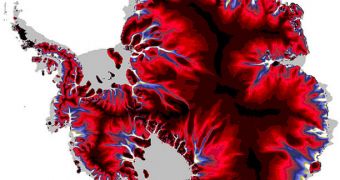While investigating ice cores collected from various sites in Antarctica, a team of experts noticed an unusual large concentration of tiny particles from meteorites inside the samples. In addition, large accumulations of extraterrestrial dust was also identified, and so the group concluded that a large space rock may have exploded above the Southern Continent several thousand years ago, the BBC News reports. Details of the findings were presented recently in The Woodlands, Texas, at the Lunar and Planetary Science Conference (LPSC).
The researchers mention that the past event was very likely similar to the 1908 Tunguska event, which affected a large swath of Siberian forests, putting thousands of trees to the ground. This class of events is regularly called “airburst,” seeing how large space rocks, either meteorites or comets, explode above the surface, rather than on impact. When such instances occur, the debris field is stretched over a very wide area of land, and becomes embedded in soil and ice records. The data that was used for the new research comes from two Antarctic ice core samples, as well as from an investigation of extraterrestrial dust. The fine particles were found in the Transantarctic Mountains, in a region called Miller Butte.
“We've got similar material spread over a very large area. It's difficult to do that with any other mechanism. These events are tricky to spot after they happen. If you go to Tunguska now, you've really got your work cut out trying to find any trace of that event – and that was 1908. What makes [the] work so exciting is that it may give us a way of spotting these events in the geological record. If these spherules are the signature, we know what to look for in future,” Imperial College London expert Dr Phil Bland told the British news agency. Italian researchers Luigi Folco and Matthias van Ginneken, based at the University of Siena, also participated in the investigation.
The team concluded that all the three samples were from the same impact because the fine particles that were discovered exhibited strong similarities in terms of texture and composition. The devastating explosion is now believed to have happened about 481,000 years ago, and all samples seem to verify this data. The investigators proposed that the space rock that made its way through our planetary defenses without burning weighed around 100,000 tonnes. For comparison, the Tunguska impactor was several tens of meter in diameter, and it exploded roughly 5 to 10 kilometers above the surface.

 14 DAY TRIAL //
14 DAY TRIAL //